Buying your first handgun
If you are new to shooting handguns, there is one super-important feature that you must look for when selecting your first: it must be conducive to practice.
Lots of practice. As in any other sport, there is no substitute for it.
In this article we will explore what features of modern handguns make practice easy, and suggest a few models that are optimized just for that.
Trigger pull
When you are shooting your pistol, just about every muscle group in your hand is working very hard. You have to hold the pistol exerting the right amount of pressure - if your grip is too heavy,
your hands will shake from the effort. If your grip is too light, you might not hold the gun steadily enough to manage the recoil consistently (or at all). Your hands are extended and must maintain
steady position. Your trigger finger must be pressing back on the trigger, but not pulling it in any direction perpendicular to the barrel axis.
As you shoot more and more, your hands get tired. The less effort it takes to fire a shot, the more practice you can get out of the shooting session, the faster you will master the sport.
The two things that contribute most to the exhaustion factor are the weight of the firearm and the force which you must apply to your trigger - the trigger pull. Of the two,
the trigger pull is the most important.
You see, the weight problem can be workarounded by shooting from the rest. After you are too tired to hold the pistol, you can still work on other aspects of shooting - aiming, trigger work, etc -
by simply resting your hands on a few sandbags. But if your trigger finger is gone, you are done for the day.
Also, variation in trigger pulls can be enormous, and the difference is much bigger here than the variation in the firearm weight. The lightest practical pistol is Ruger 22/45 "Lite" which weighs
22 oz (624 g). The heaviest is Desert Eagle Mark XIX, and just under 2kg - 3.2x difference. The trigger pull might range from 2lb (or even less on certain competition models) to over 20lb - an order of
magnitude difference.
When it comes to the trigger pull, the handgun's action is usually the defining factor.
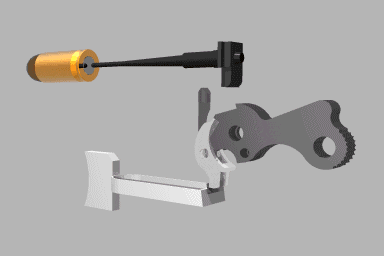
In a single-action only (SAO) handgun, be it a pistol or a revolver, the pistol must be cocked manually for the trigger to work. On the pistol this usually happens by pulling back the slide (which also pulls
back the hammer), and on a revolver this is accomplished by pulling back a hammer, which also rotates the cylinder. All the trigger does is release the hammer, so it can be - and usually is - fine tuned to
be very, very light.
Of course, in semiautomatic pistols you rarely have to cock the hammer by hand: when the pistol is loaded, you pull back the slide to send the round in the chamber, and that also cocks the hammer.
After the shot, the slide moves back and re-cocks the hammer again. The only time you would need to cock the hammer by hand is if you were to carry the gun with a round in the chamber - in my opinion,
a REALLY bad practice for a recreational shooter.
Examples of SAO handguns are 1911s, Ruger MKI, II, and III series, Desert Eagles, Freedom Arms revolvers, CZ 75 competition models, and the like. Most accurate handguns made for competition are single
action.
By contrast, in a double action only (DAO) gun pressing the trigger first cocks the hammer, and then releases it. Because the hammer must strike with considerable force, it is loaded with a stiff spring, and
so pulling it back requires considerable effort - which all comes from your trigger finger. In a revolver, in addition to cocking the hammer, pulling the trigger also rotates the cylinder. All this work
means that your trigger pull is very long AND very stiff.
Examples of DAO handguns are short-barreled "self-defense" (some people call them "suicide") revolvers such as Ruger LCR. Sig DAK (Double Action Kellerman) and DAO versions of Beretta 96 are
good examples of employing double action only design in pistols.
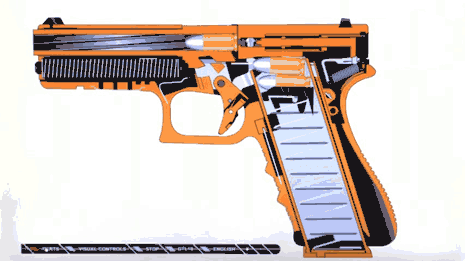
An interesting and extremely popular variety are the striker-fired pistols, the most famous of them being Glocks (but this variety of action has now been copied by pretty much everyone, from S&W in M&P series,
to Canik 55 in TP-9). In a striker fired pistol there is no hammer, and the trigger pull first pulls the striker back, then releases it. Striker fired pistols have somewhat less stiff trigger pulls than DAO
(because the spring still requires some pre-cocking) but they are still very long and most are still heavy.
Vast majority of handguns employ a combined design called DA/SA. They are capable of operating in both modes. If the hammer is not cocked, pulling the trigger is stiff, but also cocks the hammer
(and rotates the cylinder in revolvers). If you cock the hammer manually, pulling on the trigger just releases the hammer. In this case the pull is light and short (cocking the hammer usually
also moves the trigger back).
A semi-automatic DA/SA pistol can fire the first time in DA mode, and then cycling slide will ensure that subsequent shots are done in SA mode. But in reality even the first shot is almost
never fired in the double action mode: DA/SA pistols cock when the slide is pulled back to send the round into the chamber. So unless the pistol was decocked and carried around with the round
in the chamber (a really bad practice if you ask me) - even the first shot is fired single action. This is the reason why US military used SAO 1911 as a standard sidearm for almost a century.
So why do some people prefer double action guns? Military and police who operate in dangerous conditions sometimes need to be able to fire the handgun immediately after drawing it from the holster.
For them, there is no time to pull the slide or cock the hammer. They also want to train with the same trigger pull as they experience when they need to shoot, hence the requirement that even after
the slide have cycled after the shot the double action is still employed.
However, I contend that DAO pistols - and yes, this includes Glocks and S&W M&P models - are a REALLY bad choice for a beginner shooters. Here lots of practice is super important. The quick onset of
exhaustion that is inevitable when shooting DAO limits the number of shots you can fire in a single range visit severely. When shooting Glocks, my hands start shaking after 20 rounds, and I have to go home
after 40. I can (and do!) fire hundreds of rounds from my CZ in SA mode in one go.
So when buying your first gun, chose SAO or DA/SA modes, and ALWAYS try the trigger (do ask for permission to dry fire the gun, as many people are squeamish about dry-firing). Go with the crispest, lightest
single action mode you can find in your budget range.
A few examples of guns with decent triggers (numbers from my guns, your pistol may be different):
- Ruger 22/45 with Volquartsen trigger upgrade: 1.5lb trigger pull
- CZ 75 Tactical Sport: 2lb
- CZ 75 Shadow Target: 2.5lb
- Dan Wesson DA/SA revolver: 3lb
- Arminius Target 22lr DA/SA revolver: 3.25lb
- Ruger Mark III Target: 3.5lb
- S&W DA/SA revolvers: 3.5-4lb.
- Browning Buck Mark: 4lb
- Sig P226 SA/DA models: 4.5lb
- CZ 75 B, B-D and clones by Canik - 4.5-5lb
- Most 1911s, even the cheaper models will have very decent trigger. My RIA 1911 Match is 5lb, and is very crisp.
- Bersa Thunder 380: 5.25lb
- Beretta 92 and 96: 5.5lb
- Many surplus pistols have very decent trigger pulls. These will vary wildly, so better try it before buying. Mine:
- Radom P64: 3.5lb
- CZ 82/83: 4-5lb
- Walther P-1: 5lb
Weight
The next most important factor after the trigger pull is the weight of the pistol.
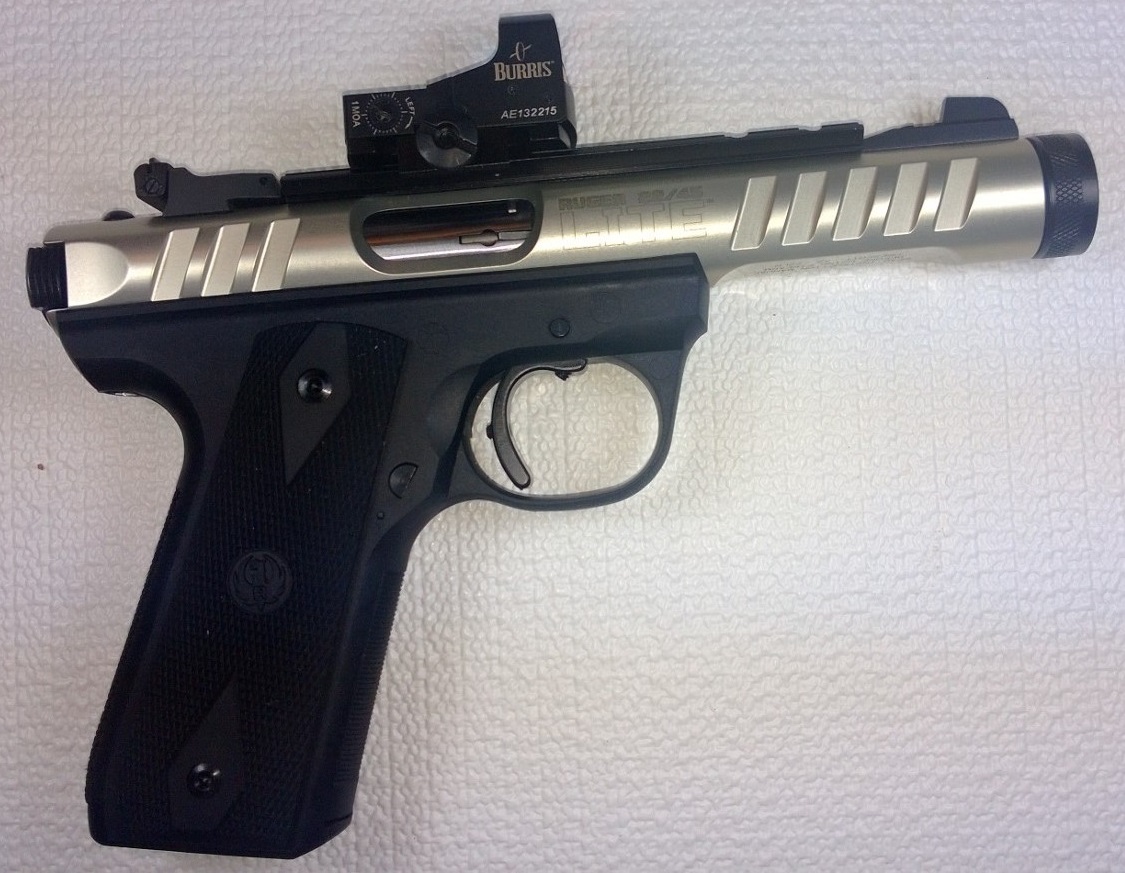
When you shoot it, you will be holding it in your extended hand (or hands). Adding a pound of weight to the end of your extended hand means that the muscles in your shoulder must increase their pull
by 15-20 pounds just to keep up, as the law of the lever suggests.
Pistols have 3 types of frames - plastic, alloy (aluminum), and steel. It just so happens that most pistols with plastic frames that I encountered, with the exception of Ruger 22/45, have really
awful triggers, so you wouldn't see much discussion of them here.
The pistols with the steel frame are very durable, have a nice heft to them, are really nice to hold, and help you manage the recoil well. They are also pretty heavy.
Alloy-framed pistols seem to be a reasonable compromise. I have seen plenty of alloy-framed Walther P-1s and CZ-82s made decades ago to prove beyond any reasonable doubt that durability is not a concern, and
the light weight is a definite plus.
- Bersa Thunder 380: 20oz
- Radom P64: 21oz
- Ruger 22/45 "Lite" with Burris FastFire III RDS: 26oz
- Compact CZs (82, 83, P-01, 75C) and Canik clones with alloy frames: 26-32oz
- Arminius 22lr with 4" barrel: 34oz
- Browning Buck Mark: 35oz
- CZ 75 B, B-D, and Canik 55 clones with steel frames: 34-38oz
- S&W 64-3 with 4" bull barrel: 37oz
- Dan Wesson 357 Magnum with 6" barrel: 42oz
- CZ 75 Tactical Sports: 46oz
- Ruger Mark III Target with 5" Bull barrel and Bushnell Trophy scope: 52oz
Accuracy
When you are learning to shoot one problem you do not want to face is the accuracy of your pistol. If the gun is not too good you will not know when your abilities end, and the gun's
disabilities start. Quite often people blame themselves for bad shots when the gun is at fault.
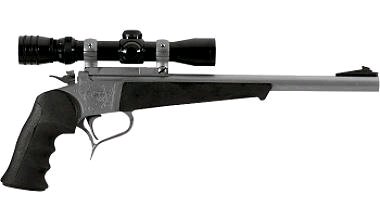
Accuracy of the handgun depends mostly on the number of the parts that move when the gun fires, and on the way these moving parts fit together.
Inherently the most accurate pistols are the ones built around actions where nothing moves during the shot. The most popular example is Thompson Center Contender, a single-shot
break-action pistol. With a lucky barrel (which are interchangeable, so you can easily switch calibers) 1" 5-shot groups at 100 yards are achievable.
There are also lever action pistols, falling block pistols, and even bolt action pistols. While very accurate, with the exception of Contender and so called
"free pistols", they are not designed to be fired off hand comfortably, and I do not recommend them to a beginner shooter.
The next type of action is blowback-operated pistols. Here the barrel is attached to the frame. When the pistol fires, the cartridge expands and grips the walls of the chamber, thus creating
a gas seal and ensuring that the gasses are expanding forward to propel the bullet. As the bullet is leaving the barrel, the pressure drops, the case shrinks, and the slide is pushed
rearward to cycle the action.
In a blowback pistol there is very little movement of internal components until the bullet is outside the barrel. So these guns tend to be very accurate, sometimes - astoundingly accurate.
For example, Ruger Mark III, Ruger 22/45, and Browning Buckmark are often used in club-level competitions.
They can be counted on holding sub-inch 10-shot groups at 25 yards, which means that you can consider the pistol "accurate enough" and focus on developing your own skills.
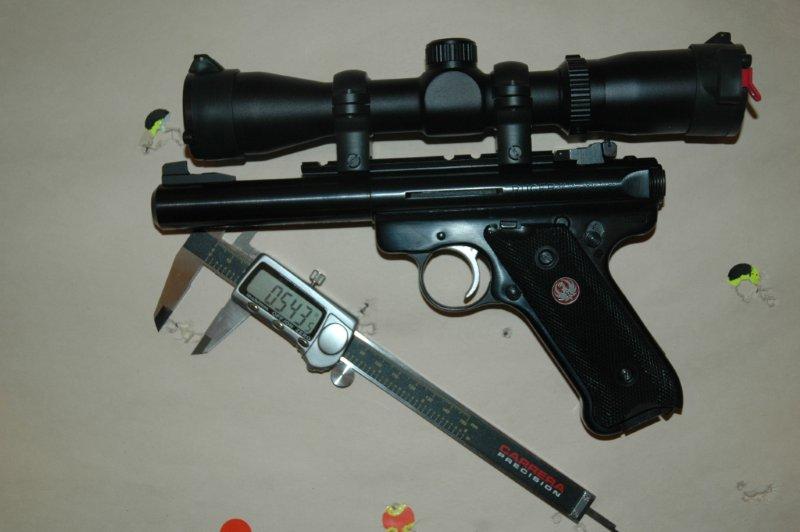
Blowback guns in centerfire calibers tend to be built for compactness and concealability, and thus feature very short 3-3.5" barrels. Despite the short barrels
even very inexpensive guns such as Bersa Thunder 380 or CZ 82/83 produce 3-4" groups at 25 yards with ease, very decent for guns this size.
Next in line when it comes to accuracy are revolvers. You would think that revolvers should be similar to single-shot guns in accuracy, but it is not universally true. Even in the best
revolvers the cylinder wiggles a little bit, the bore is not 100% concentric with the cylinders, and the gap between the cylinder and the barrel is not quite uniform, leading to slightly different
amount of gasses escaping for different chambers. All this leads to variability between shots and widens the groups.
There are, nevertheless, many really well-made revolvers, and when this is the case, a revolver can be very competitive with the single-shot guns as far as accuracy is concerned.
Freedom Arms makes the world's most accurate ones, with most 5-shot factory targets I've seen easily clearing 0.5" at 25 yards. With the price tag of around $2000 they are probably
too much for a beginner.
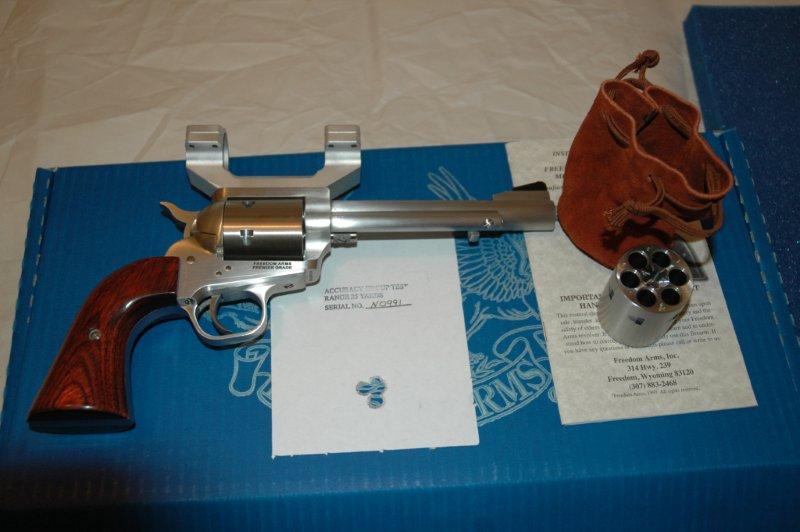
Smith & Wesson and Dan Wesson revolvers are an accurate and economical alternative. The ones with 4-6" barrels can be counted on producing 1.5-2.5" groups at 25 yards. Of course the
same cannot be said about various "self-defense" revolvers with shorter barrels - these are notoriously inaccurate. Some call them "suicide revolvers", implying that they only can hit
things point blank, and many ranges prohibit them entirely on account of accuracy. Stay away from these guns!
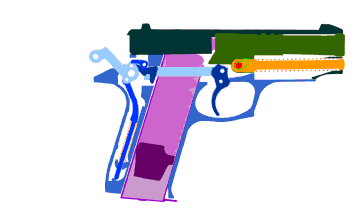
In a recoil-operated handgun barrel moves a short distance with the slide when the gun is fired and the bullet is still in the barrel. It then hits the stop in the frame (locks),
and the slide continues to move back to cycle the action. While doing this, the barrel tip usually moves up. The accuracy of such pistol depends very much on extremely tight tolerances
in the manufacturing process, and vast majority of recoil-operated handguns are not very accurate.
The best in this category are hand-tuned pistols such as CZ 75 Shadow Target, Czechmate, Les Baer 1911s and the like. They can be expected to shoot roughly 1-1.5" 5-shot groups and 25 yards,
and cost from one to three thousand dollars.
More "pedestrian" recoil-operated models can be counted on grouping within 3-5" at 25 yards. On the more accurate end of this range are CZ 75 variants and some of their clones, on the less
accurate, Glocks, S&W M&Ps, and the like, and Sigs and Berettas are in the middle.
It should be noted that the market is flooded with "match barrels" for various firearms. With today's technology making a decent barrel for a pistol is easy. For the most part, excluding
REALLY cheap guns, barrel quality is not what defines a pistol's accuracy - it is the mating of the barrel with the rest of the components.
Gas-operated locking bolt pistols are rare, but they do exist. The most famous of them is Desert Eagle, and the pistol versions of AK-47 belong in this category. The action works essentially like
an AK-47: there is a port in the barrel towards the end, it siphons some of the gasses into a piston chamber. The piston pushes on the bolt, rotates and unlocks it, and then pushes it back
to cycle the action. AK-47s are not considered to be accurate as rifles, but in their pistol form they are better than most handguns in terms of accuracy.
Guns in this category are very heavy, and aren't really suitable to be fired off-hand, so I would not recommend them to a novice.
Recoil
If you go on any of the gun auction sites, you will find that a significantly larger percentage of large-caliber handguns are sold in "like new" condition than the ones in small calibers.
The description of the auction would say something like "fired 20 shots, have been in the safe ever since".
There is a reason for that: large caliber guns are just not very pleasant to shoot. So people buy them for their size and power, try them once or twice on the range, then store them
and never shoot them again. I should know: I have my very own Freedom Arms Model 83 in 454 Casull in the safe. I shoot it approximately once a year. It is my most accurate gun when I shoot from
the rest, and my least accurate gun when I shoot off-hand: my hands are not strong enough to hold it tightly enough to control the recoil and the weight and aim at the same time.
I may sound as a broken record, but as a new shooter, you will need something that you can shoot a lot. This means a careful choice of technology and a caliber, with the focus on
training rather than power.
It is of course obvious, but 22lr pistols and revolvers, regardless of the action, will have the lowest recoil and will be the easiest to shoot. The recoil of a massive bull-barreled
Ruger MKIII Target is nonexistent. The recoil of even the lightest of the 22lr guns, Ruger 22/45 "Lite" is extremely light.
Excluding the rimfire handguns, recoil operated guns have the lowest recoil, because some of it gets amortized by the many moving parts of the gun. It may be a surprise, but
the felt recoil of my 1911 in 45ACP (a recoil-opeprated gun) is lower than the felt recoil of CZ 82 in 9mm Makarov (a blowback gun), despite the fact that the bullet weighs twice
as much, and there is twice as much powder in the cartridge.
Blowback guns recoil quite a bit, and this is one of the reason that they for the most part top out at 9mm Makarov (delayed blow-back guns in 9mm Luger do exist, but they are rare),
but the most appropriate round for a new shooter is 380ACP.
Revolvers lose some if its recoil to gas leakage around the gap between the cylinder and the barrel, and some to the generally heftier weight. That said, most revolver cartridges
are very powerful, and for a new shooter I would recommend getting one in 38 Special. This is the lowest power in popular revolver calibers, but it is surprisingly accurate, least expensive,
and a pleasure to shoot.

Sights
When shooting with iron sights, correct aiming is the most important component of accuracy. Human eye can only focus on one thing, and this thing must be the front sight
of your handgun. The rear sight should be somewhat out of focus, and the target itself should be very much out of focus.

Accomplishing this is surprisingly difficult: the natural reflex for an eye is to scan the environment, and so it is hard for it to maintain focus on one thing, especially
when there are many distractions around. This means a few things.
First, good target sights should minimize the distractions. This means no dots, no night sights, no fiber optic sights, etc. Illuminated dots are useful when shooting in general
direction of a target in poor lighting conditions. Hopefully, this is not what you are going to do. For target practice, all these extraneous features interfere with your
ability to focus, and are actually detrimental to accuracy.
Second, both front and rear sights must be perfectly square. When you have to align several lines as straight as possible, it is imperative that the lines themselves are actually
straight. Here are the pictures of two sights: cheap military sights for a Makarov pistol, and very nice target sights for CZ 75 Tactical Sports. Notice the
differences in machining, and as an added bonus the serrated surface of the high quality sights - it reduces glare.
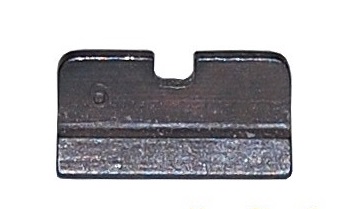
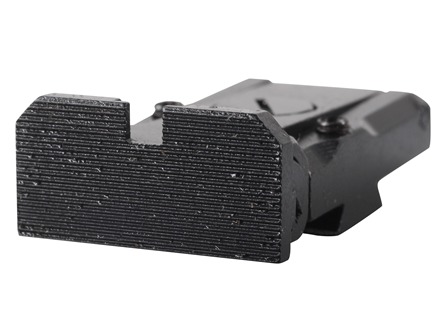
If the edges of your front and rear sights are not perfectly straight, you will be aligning a sloping triangle inside a crooked square, and who knows what the bullets will
hit...
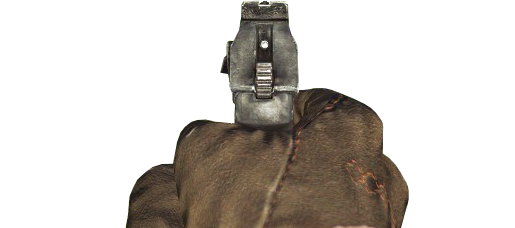
What to buy?
In my opinion, the absolutely best choice for learning to shoot accurately is one of the following three pistols: Ruger 22/45 "Lite", Ruger MKIII Target, and Browning Buckmark Camper.
All three are blowback-operated 22lr pistols. They are cheap to shoot, extremely accurate with a very wide range of ammunition (including some very inexpensive brands such as CCI Target
and American Eagle), are essentially recoil-free, and have excellent iron sights.
Of these three models Buckmark has the best out of the box trigger, but Ruger pistols have more aftermarket parts, including excellent trigger kits from Volquartsen which are in turn better
than the factory trigger in Buckmark. The 22/45 comes with an absolutely atrocious trigger out of the box, and it MUST be replaced. Also, one must be extremely careful when mounting the scope rail
on a "Lite", as the screws supplied with the pistol are very short, and the shroud is made from a very soft aluminum - so the threads are almost impossible to not strip.
Here are the in-depth reviews of Ruger Mark III and Ruger 22/45 "Lite".
The only problem with all three models - they are extremely difficult to find, so your primary constraint is going to be the ability to buy, and the only option for much of
the year may be Gunbroker. If I were to be buying my first pistol again, I would buy any one of these three without hesitation.
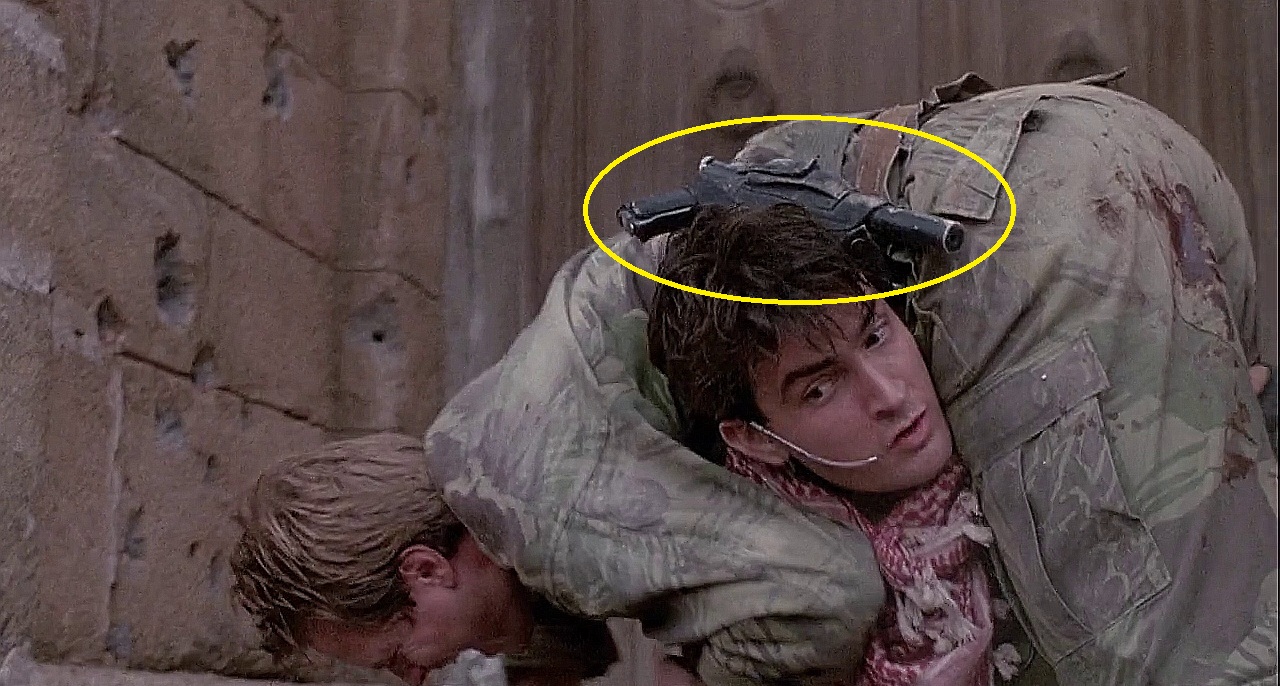
Another thing to keep in mind, Ruger model names are extremely confusing. They have two lines - MKIII and 22/45, and sometimes sellers use them interchangeably. There is, however,
a big difference. MKIII has an alloy or stainless frame, whereas 22/45 has a plastic frame. 22/45 also has a much worse trigger: it is heavy and creepy, and must be replaced by a
Volquartsen kit, so figure another $100 just to make it usable. Plastic frame makes sense on a "Lite" model, where the whole pistol is very light (and yes, you will still have to
replace the trigger!), but otherwise I recommend staying away from it and buying an MKIII, specifically, one of the following three models: MKIII512, KMKIII512, or MKIII512TG.
Of course, these pistols might seem too specialized (although did you know that Ruger MKII is in fact used by US Navy Seals?) and
impractical. If shooting a "real life" pistol is a big consideration, here are a few alternative.
For a small, concealable pistol, if money is not a concern I recommend Walther PPK/S - AKA the Agent 007 gun. It is a DA/SA blowback pistol chambered in 380 ACP, is small, well-made, and,
for the size, decently accurate. It has a reasonable SA trigger that breaks around 5lb. It is also rather expensive, with the street price well above $600. (An important consideration
when buying a Walther is where it was made. The guns manufactured in US under license from Walther are considered much less valuable than the ones made in Germany, even though
they may shoot the same, so you should keep this in mind when buying one).
If money is a concern, either Bersa Thunder 380 or a military surplus CZ 83 are excellent alternatives. The package is very similar, the accuracy is the same, and the triggers are also
pretty good, around 4.5-5.25lb. As a beginner shooter, I would stay away from military surplus CZ82 and other Walther-derived guns in Makarov caliber, including the Makarov itself. While
the ammunition is cheaper and easy to find, Makarov round is more powerful than 380ACP, and the recoil is considerably worse, sufficiently so that it makes long trips to the range difficult.
For a larger service handgun, I prefer CZ 75 or its clones. If money is not a concern, CZ 75 Shadow Target and Tactical Sports models are amazingly accurate, have excellent sights,
very manageable recoil, and triggers that are possibly the best in semi-automatic pistols, but retail for around $1200. If money is a problem, regular CZ 75 can be had for $500-$600, or
Canik 55 clones such as S-120 or StingRay are every bit as good and are much easier to find for much less. We usually carry
a few in our own store.
If you are looking for a revolver, you cannot go wrong with S&W Model 10 or Model 64 in 38 Special. They are low-recoil, very accurate, relatively light as far as medium-sized guns
go, have very tolerable recoil, and their triggers are nothing short of amazing. They can often be had on Gunbroker for $350-$400, and we carry them when I can find a good source. I do not
recommend a larger revolver caliber for a beginner - while the 357 Magnum might look attractive, you will simply not shoot it enough to get really good.
Questions or comments? I will be happy to hear from you at sergey@preciseshooter.com.